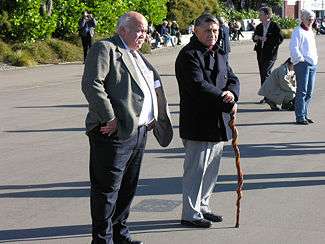Kaumātua

Kaumātua are elected tribal elders of either gender in a Māori community who have been involved with their whānau for a number of years. They are appointed by their people under the belief that the chosen elders have the capacity to teach and guide both current and future generations. Kaumātua must display a good knowledge of tikanga, history, and Te Reo; and their contribution must ensure that the mana of the whānau, hapū and iwi are maintained. Barlow (1994) refers to kaumātua as being the "keepers of knowledge and traditions of the family, sub-tribe and tribe". Although the term kaumātua is widely used to refer to male elders, male kaumātua are more correctly called koroua or koro, and female elders are called kuia.
Characteristics
Kaumātua never self-proclaim their elder status since this is not allowed according to the rules of mana; instead the people acknowledge an elder's kaumātua status.[1] Other characteristics that kaumātua possess are humbleness, honesty, and integrity, which they display through their words and actions.[1] Kaumātua usually have specialised skills in a particular area e.g. whakapapa, tikanga, etc. as well as information on other people who may have expertise in other fields.[1]
Powers
In the past, kaumātua were believed to be "the reincarnation of a person who had acquired a supernatural or godly status after death, and who had become the protector of the family".[2] These supernatural powers were believed to allow the "reincarnated spirits" to return to earth to provide influential guidance to the remaining family.[2] It was believed that these powers allowed the kaumātua transform themselves into birds, fish and insects.[2] Elders of the tribe made reference to these transformed states when predicting the future and fortunes of the tribe.[2] Additionally, along with leadership and guidance of family and marae, many kaumātua exert a protective influence over the seas, rivers, lands and forests.[2]
Relationships with health organisations
Kaumātua are deemed essential to any Māori community as well as health organisations which have affiliations with Māori. This includes kaimatai hinengaro (clinical psychologists), especially if they treat Māori clients or carry out health research on Māori participants. Kaumātua that are involved in health organisations are required to play pivotal roles in guiding kaimatai hinengaro, similar to their role in the Māori community.
Non-Māori kaimatai hinengaro treating Māori clients or carrying out medical research on Māori are realizing the benefits of working under the assistance of kaumātua. For kaimatai hinengaro carrying out health research on Māori, kaumātua of local iwi can be contacted through Te Puni Kōkiri. The offices of Te Puni Kōkiri employ Māori liaison authorities who maintain a "register of local iwi contact people".[3] Once contact is made, research objectives and outcomes are discussed with kaumātua and other tribal elders. Key contact individuals are appointed for both research and iwi sides. While the contact person for the research may be the kaimatai hinengaro, kaumātua usually represent the iwi and provide feedback on satisfaction with research methods and treatment of Māori participants.
References
- 1 2 3 "Tikanga definitions of kaumātua". maori.org.nz. Retrieved 17 August 2004.
- 1 2 3 4 5 Barlow (1994). Tikanga Whakaaro: Key Concepts in Māori Culture. Auckland: Oxford University Press.
- ↑ Smith, L.T.; Smith, G.H.; McNaughton, T. (1999). Working with Māori / Te Mahi Tahi Ki Te Māori: A Beginner's Guide for Employers. Auckland: Equal Opportunities Trust.